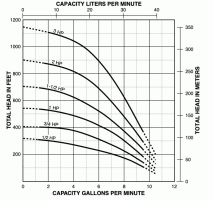Michaelco
New Member
We want to filter iron, manganese from a new well, prior to it entering a couple of 5,000 gallon storage tanks. .
Our Iron levels are .740 mg/l
and Manganese .051 ppm.
There is also a slight sulfur smell (hydrogen sulfide), but figure the filter will be able to deal with that as well.
Water usage:
The well, is set to pump at 10 gpm, and has the heaviest use when we're irrigating our main orchard - we use drip irrigation, which uses ~3000 gallons per irrigation. We have other fruit/nut trees we irrigate which we schedule for a different day. The most we have used across any two days is 5,000 gallons. The house use is negligible compared to the irrigation - less than 50 gallons a day.
We're looking at an Air Over Media type filter whose controller provides an output for controlling the well's submersible pump.
It seems most of the iron filters are typically located on a line that's always under pressure, so there is no problem when the filter goes into a backwash/regen mode.
In our case, the water line heading into the storage tanks will not be under pressure, and there won't be any water flow unless the tanks are low and has turned on the well's submersible pump.
I posted on the Water Softener Forum, received the following caution about using an iron filter with our setup:
“The AIO style filter needs pressure on the tank at all times to contain the air pocket. Sending 10 GPM through an AIO filter would probably pull the air bubble right out so you would want to add a flow restrictor downstream of the filter”. I would think this problem has been solved before - How have others handled this situation?
I was also told the Fleck 5800 SXT filters provide a relay output which would turn on the pump when the filter starts regeneration. In addition, I found Clack makes water treatment valves with relay output, and WaterStore.com filters use Clack valves - I don’t know anything about the quality of Clack valves, nor, for that matter any of the various manufacturers, but it looks like they make a reasonable valve. I’m still waiting for a response, from waterestore.com, confirming their iron filters use the Clack water treatment valves with relay outputs.
Any thoughts on other iron filters to consider? I have looked at other filtering approaches like TripleOs ozone system, but didn’t like the maintenance requirements, and unsure whether a single system would work with two 5k storage tanks connected in series.
Any design ideas on how to incorporate iron filters to avoid any pitfalls?
Thanks,
Michael
Our Iron levels are .740 mg/l
and Manganese .051 ppm.
There is also a slight sulfur smell (hydrogen sulfide), but figure the filter will be able to deal with that as well.
Water usage:
The well, is set to pump at 10 gpm, and has the heaviest use when we're irrigating our main orchard - we use drip irrigation, which uses ~3000 gallons per irrigation. We have other fruit/nut trees we irrigate which we schedule for a different day. The most we have used across any two days is 5,000 gallons. The house use is negligible compared to the irrigation - less than 50 gallons a day.
We're looking at an Air Over Media type filter whose controller provides an output for controlling the well's submersible pump.
It seems most of the iron filters are typically located on a line that's always under pressure, so there is no problem when the filter goes into a backwash/regen mode.
In our case, the water line heading into the storage tanks will not be under pressure, and there won't be any water flow unless the tanks are low and has turned on the well's submersible pump.
I posted on the Water Softener Forum, received the following caution about using an iron filter with our setup:
“The AIO style filter needs pressure on the tank at all times to contain the air pocket. Sending 10 GPM through an AIO filter would probably pull the air bubble right out so you would want to add a flow restrictor downstream of the filter”. I would think this problem has been solved before - How have others handled this situation?
I was also told the Fleck 5800 SXT filters provide a relay output which would turn on the pump when the filter starts regeneration. In addition, I found Clack makes water treatment valves with relay output, and WaterStore.com filters use Clack valves - I don’t know anything about the quality of Clack valves, nor, for that matter any of the various manufacturers, but it looks like they make a reasonable valve. I’m still waiting for a response, from waterestore.com, confirming their iron filters use the Clack water treatment valves with relay outputs.
Any thoughts on other iron filters to consider? I have looked at other filtering approaches like TripleOs ozone system, but didn’t like the maintenance requirements, and unsure whether a single system would work with two 5k storage tanks connected in series.
Any design ideas on how to incorporate iron filters to avoid any pitfalls?
Thanks,
Michael

